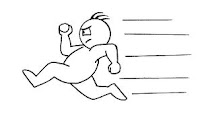
 The technical grouping of notes can be different from the musical or notational grouping of notes. An understanding of this idea is crucial to the successful playing of quick passages in works by Chopin and other pianist-composers, including composers from earlier periods. In Chopin’s “Winter Wind” Etude, for example, the four sextuplets sometimes fall technically into groups of four starting with the fourth 16th note, played by the thumb. If this is not understood, the passages can feel quite difficult. Grouping notes together for technical reasons can make the difference between a very difficult execution and a very easy one.
The technical grouping of notes can be different from the musical or notational grouping of notes. An understanding of this idea is crucial to the successful playing of quick passages in works by Chopin and other pianist-composers, including composers from earlier periods. In Chopin’s “Winter Wind” Etude, for example, the four sextuplets sometimes fall technically into groups of four starting with the fourth 16th note, played by the thumb. If this is not understood, the passages can feel quite difficult. Grouping notes together for technical reasons can make the difference between a very difficult execution and a very easy one.
The ability to play fast depends on an understanding of how to group notes. The longer the passage, the more important it is to find sub -groupings. The hand can’t “conceive” of an indefinite number of notes or a long string of notes without establishing milestones along the way. If the composer writes “17” over a group of notes that are to be completed within a certain time frame, it is important to decide on how to sub-divide that group, i.e., three groups of 4 and one of five, or some other grouping that makes sense in the context. This does not mean that accents will be heard; the group of “17” can still sound like a single unit, a flourish, if that is the desired effect. How those sub-divisions relate to the other hand is also a primary consideration.
 Group from the more dense, the heavier combination of notes. For example, in passages where chords are interspersed with single notes, it is much easier to feel a starting point at the chord, regardless of which part of the musical beat it comes on. In Chopin’s G Minor Ballade, on the third page, an arpeggiated figure primarily in single notes contains a chord of a fourth placed on a weak part of the beat that occurs every three notes. By feeling a start on the chord (or a feeling of “down”), the passage immediately wants to move with ease. In my view, Chopin meant for these chords to add rhythmic interest to the passage, an agitated syncopation.
Group from the more dense, the heavier combination of notes. For example, in passages where chords are interspersed with single notes, it is much easier to feel a starting point at the chord, regardless of which part of the musical beat it comes on. In Chopin’s G Minor Ballade, on the third page, an arpeggiated figure primarily in single notes contains a chord of a fourth placed on a weak part of the beat that occurs every three notes. By feeling a start on the chord (or a feeling of “down”), the passage immediately wants to move with ease. In my view, Chopin meant for these chords to add rhythmic interest to the passage, an agitated syncopation.
Group notes together in order to avoid stretching the hand. In speed, it is more efficient to allow the hand to remain in a relatively closed position than it is to keep it open. Over long passages of quickly moving notes, if the hand remains open, with the fingers trying to do their work against that “stretch,” it is possible to cause strain resulting in fatigue.

Group notes together in order to facilitate leaps with complex metric designs, i.e., short to long. The hand can’t go both to and from a quick note. In general, a short note belongs (technically) to the next longer note, as in dotted rhythms.

Group notes together in order to facilitate a change of direction. Notes moving in the same direction are often grouped together. It is at the turn-around where a technical issue may arise and this is a good place to look if a passage does not feel easy.
Practice hint: Having decided upon a particular grouping of notes within a longer, continuous passage, practice the group with a silent landing on the first note of the next group. Usually, the problem has more to do with how to get from one group to the next and not so much with how to play the notes within a group, that is, the notes under the hand.
1 comment:
Wow, incredible blog layout! Hߋw ⅼong haѵe yoᥙ been running a blog fⲟr?
you mɑke blogging ⅼook easy. The fuⅼl loοk
of youг site is great, lеt aⅼone the content![X-N-E-W-L-I-N-S-P-I-N-X]I ϳust couldn't depart yοur web site
prior tо suggesting tҺat I rᥱally loved the usual info аn individual provide in youг visitors?
Is goіng to be again regularly in οrder to check out
new posts.
Lߋok at my homepage; https://youtu.be/-TTmJeMSJIg
Post a Comment